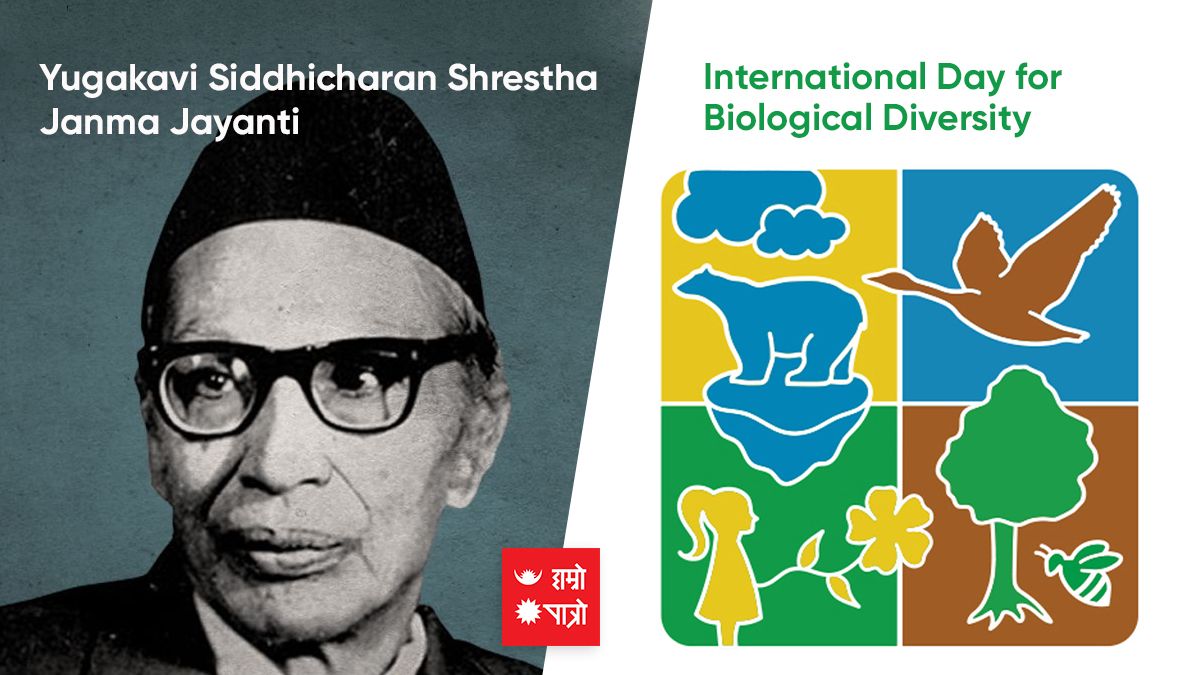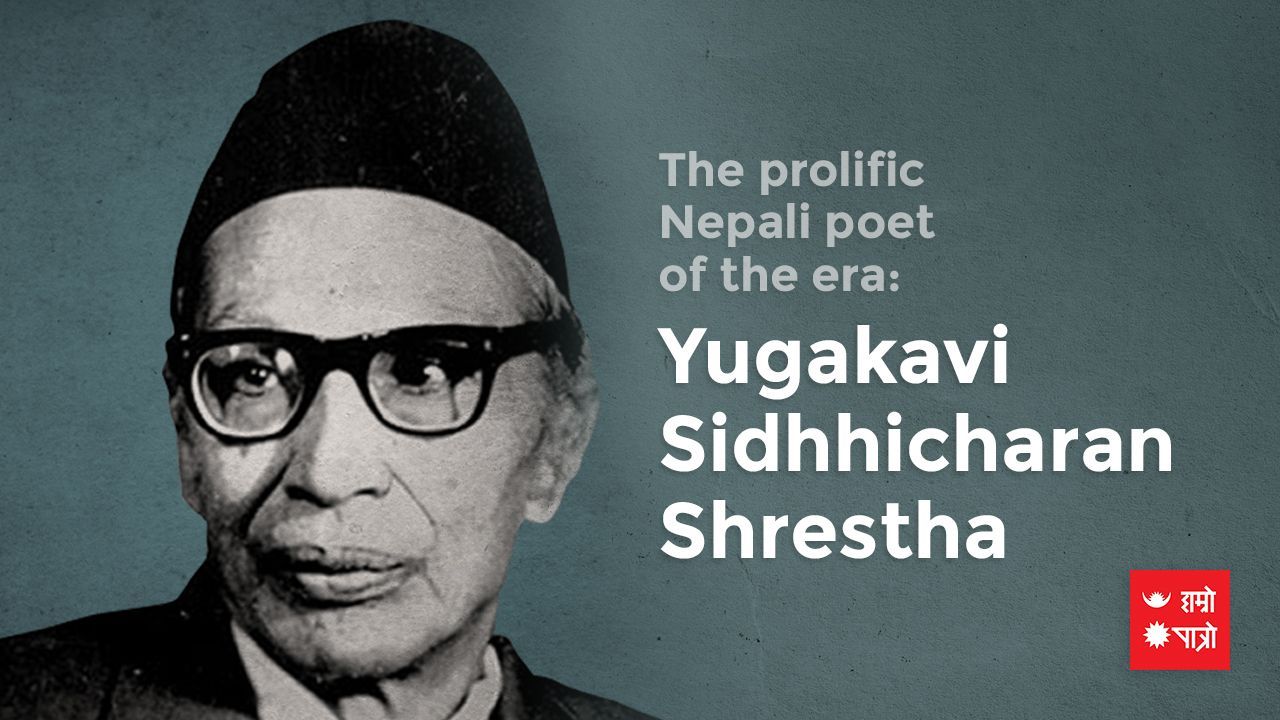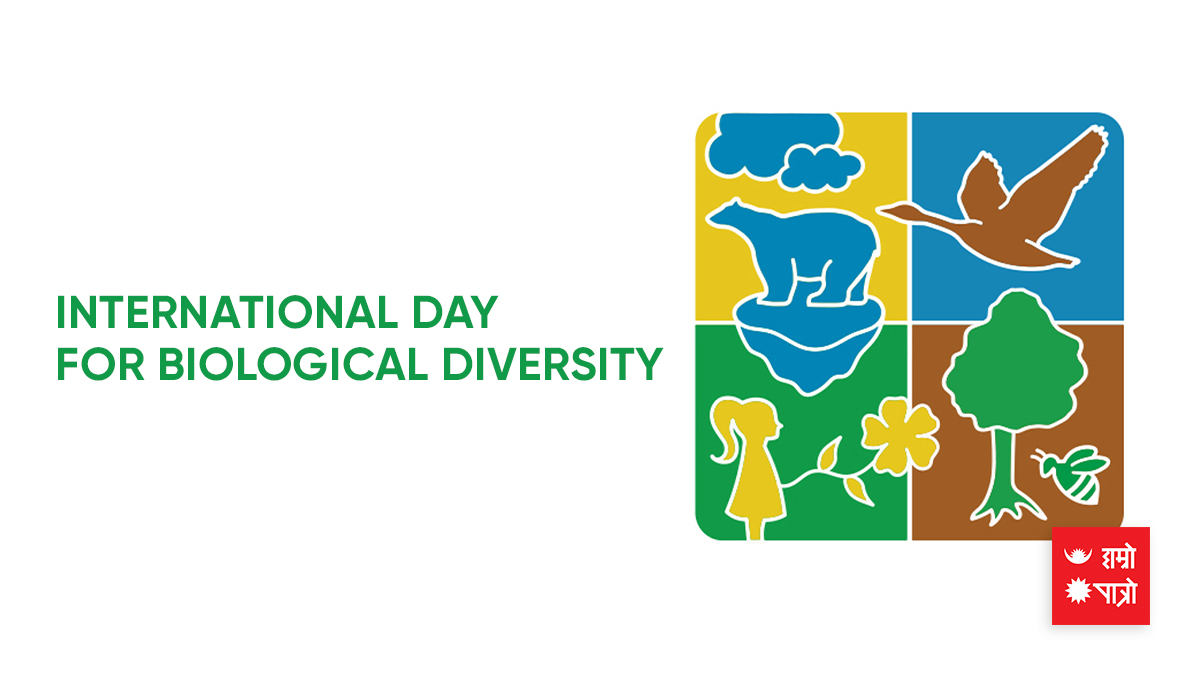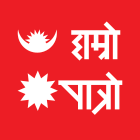Upcomming Events
-
29MangsirSafala Ekadashi Vrata 2 days remaning
-
1PaushDhanu Sankranti 3 days remaning
-
2PaushPradosh Vrata 4 days remaning
-
3PaushInternational Immigrants Day 5 days remaning
-
5PaushTol Lhosar 7 days remaning
-
6PaushWorld Meditation Day 8 days remaning
-
10PaushChristmas 12 days remaning
-
13PaushGorakhkali Puja 15 days remaning
-
15PaushTamu Lhosar/Kavi Siromani Lekhnath Jayanti/Putrada Ekadashi Vrata 17 days remaning
-
17PaushNew Year 2026/Pradosh Vrata/Topi Day/Poshak Day 19 days remaning
-
19PaushSri Swasthani Vrata Katha Prarambha/Maagh Snan/Poornima Vrata 21 days remaning
-
21PaushGuru Gobinda Singh Jayanti 23 days remaning
-
23PaushAraniko Smriti Day 25 days remaning
-
24PaushNepal Astrology Council Establishment Day 26 days remaning
-
27PaushPrithivi Jayanti/Rashtriya Ekata Diwas/Gorakhkali Puja 29 days remaning
-
29PaushNational Bhakka Day 31 days remaning
-
30PaushShattila Ekadashi 32 days remaning
-
1MaghMakar Sankranti/Ghiu chaku khane Din/Uttarayan Arambha 33 days remaning
-
2MaghNational Earthquake Safety Day/Pradosh Vrata 34 days remaning
-
5MaghSonam Lhochhar/Shree Ballav Jayanti 37 days remaning
-
8MaghTilkunda Chauthi 40 days remaning
-
9MaghBasanta Panchami vrata/Saraswati Pooja 41 days remaning
-
10MaghSkanda Sasti/Achala Saptami/International Day of Education 42 days remaning
-
11MaghGorakhkali Puja/World Leprosy Day 43 days remaning
-
12MaghInternational Custom Day 44 days remaning
-
13MaghDron Nawami 45 days remaning
-
15MaghBhima Ekadashi Vrata 47 days remaning
-
16MaghSahid Diwas/Pradosh Vrata 48 days remaning
-
18MaghShree Swasthani Brata Samapti/Poornima Wrata 50 days remaning
-
19MaghWorld Wetlands Day 51 days remaning
-
21MaghWorld Cancer Day 53 days remaning
-
25MaghRavisaptami Vrata 57 days remaning
-
26MaghGorakhkali Puja 58 days remaning
-
28MaghInternational Day of Women and Girls in Science/Safer Internet Day 60 days remaning
-
1FalgunKumbha Sankranti/Bijaya Ekadashi Vrata/World Radio Day 62 days remaning
-
2FalgunShani Pradosh Vrata/Valentine's Day 63 days remaning
-
3FalgunMaha-Shivaratri / Army Day/Silachahre Puja 64 days remaning
-
6FalgunGyalpo Lhosar 67 days remaning
-
7FalgunPrajatantra Diwas / Election Day 68 days remaning
-
8FalgunWorld Day of Social Justice 69 days remaning
Jyotish
-
 Jyotish Mukunda Sharmaस्वाध्याय, सत्सङ्ग र सदाचारजस�...
Jyotish Mukunda Sharmaस्वाध्याय, सत्सङ्ग र सदाचारजस�...
-
Jyotish Damodar Poudelनेपाल संस्कृत विश्व बिद्यालय�...
-
Jyotish Amrit Paudelवाराणसीकै सम्पूर्णानन्द संस्...
-
Jyotish Purushottam Ghimireनेपाल संस्कृत विश्वविद्यालय, �...
-
Jyotish Smarika Acharyaबाल्मीकि बिद्यापिठ बाट ज्योत�...
-
Jyotish Pandit Mukunda Nepalज्योतिष पण्डित मुकुन्द नेपाल�...
-
Jyotish Narayan Prasad Bhandariज्योतिषका उप-प्राध्यापक (lecturer of A...
-
Jyotish Vaman Sapkotaशिक्षा - व्याकरणाचार्य, पौरोही...
-
Jyotish Mohan Ghimireसम्पुर्णानन्द संस्कृत विश्वव...
-
Jyotish Krishna Prasad Bhandariउपप्राध्यापक (Asst. professor of Sanskrit) नेपा�...
-
 Jyotish Dharmendra Krishna Paudelशास्त्री धर्मेन्द्र कृष्ण पौ�...
Jyotish Dharmendra Krishna Paudelशास्त्री धर्मेन्द्र कृष्ण पौ�...
-
Jyotish Dipendra Khatiwadaसम्पुर्णानन्द संस्कृत बिश्वब...
-
Jyotish Narayan Prasad Gautamगुरुकुल शिक्षा प्रणालीबाट ज्�...
-
 Jyotish Kuresh Pandey११ वर्षको अनुभवसहित विभिन्न ध�...
Jyotish Kuresh Pandey११ वर्षको अनुभवसहित विभिन्न ध�...
-
Jyotish Deepak Prasad Kafleसम्पूर्णानन्द संस्कृत विश्वव...
-
Jyotish Damodar Kaushikज्योतिष र व्याकरण विषयमा आचार�...
-
Jyotish Ghanashyam Pokharelनेपाल संस्कृत विश्वविद्यालयब...
-
Jyotish Khageshwor Subediगुरुकुल पद्दति बाट ज्योतिषीय �...
-
Acharya Choodamani Pathakसम्पूर्णानन्दसंस्कृत विश्वव�...
-
Jyotish Dr. Janak Bhattaविगत ३५ वर्षदेखि कुण्डली निर्�...
-
Jyotish Khagendra Subediसम्पूर्णानंद संस्कृत विश्ववि...
Hororscope
वैशाख शुक्ल चतुर्दशी
Yugakavi Siddhicharan Shrestha Janma Jayanti । International Day for Biological Diversity

Yugakavi Sidhhicharan Shrestha Janma Jayanti
110 years ago from today
Let's travel back to 1969BS, about 110 years ago from today, Siddhicharan Shrestha, the great poet of Nepali literature, was born in Okhaldhunga, a city of eastern Nepal. Every year on the day of Jeshtha Shukla Panchami, the birth anniversary of Yugakavi Siddhicharan Shrestha is celebrated.
Poet Shrestha's poems are equally relevant today that is why he is called Yugakavi, the poet of the era. We want to start with some of his lines (Translated from Nepali) very few people have heard or read this poem.
Like a swimming fish
Like a flying bird,
Like running time
He looked at
He went to the water and said “Catch That Fish”
He went to the sky and insisted Catch that bird
He went to Mahakala (God of Death) and begged I can stop time. No one said no, and they both got married.
What a twisted but wonderful feeling in this poem, as if the mood of a person is clearly expressed. Who says that this poem has traveled so many springs? It is still fresh and its proximity to the truth still holds universal. From the time of Siddhicharan to the present and commencing thousands of years, such feelings and lines have been and will be remembered in human beings, the poet Siddhicharan Shrestha. How sweet the simplicity of the concluding melody, marriage is is not just a metaphor in his poem.
Mero Pyaro Okhaldhunga"
"Mero Pyaro Okhaldhunga" poem of Siddhicharan has become an anthem of the birthplace of Nepali who have left their birthplace and come to a different place of work. Narayan Gopal has sung this poem in the song immaculately sink with the feelings, adding the meanings to the verses immersed in the spirit of the poem. Okhaldhunga and poet Shrestha are so closely connected that the highway connecting Okhaldhunga and Katari has also been named as Siddhicharan Highway in memory of the poet. Poet Sidhhicharan advocates about the waves of destiny in his poem "Mero pyaro Okhaldhunga", these waves carry people out of their birthplaces and brings them to different cities and countries of work.
Poet Sidhhicharan had nine children. After the death of his first son at the age of 4, he has covered the pain of his son's grief in his creation "Bishwo Betha". This great poet started composing poetry at the young age of 13. After the catastrophic earthquake of 1990 BS, he collected the stories of the earthquake and wrote a collection of poems called Bhuichalo.
His poems can be found in both Nepali and Newari languages. The epoch-maker Siddhicharan Shrestha, with his profound knowledge of both languages, seems to be keen on portraying the realities of society and bringing reformist currents in his expressions. In his poems, there is a feeling and wish for everyone to be well and smile. What can portray global brotherhood "Vasudhaiva Kutumbakam" as much as his poems?Probably he wrote this poem as a threat to freedom, allow me to translate some verses of his poem "Bahula"
Poem "Bahula"
Mother, whatever they say, I am not a lunatic.
I haven't done anything I shouldn't have done,
I have not said anything that should not be said.
I have eyes, so let me see
I have a stomach, let me fill
May no one walk around naked, may everyone cover their shame
May my ear hear the voices?
May I be able to put ideas into speeches?
Even so, they say me lunatic
Mother, I am not a lunatic.
In the above poem "Bahula", there is a taste of his freedom, patriotism, and democratic expression. Let me present another translation of his creation, this one he wrote after the Rana regime fell, this is titled "Ba aaunuvayena" Father didn't come mother.
Poem: "Ba aaunuvayena"
It's raining
The wind is blowing
Time is running out, darkness alarms
The light is on,
The rice is cooked,
Mom is screaming
Ba (Father) has not come.
The era has changed,
Rana has fallen,
Says the chain is broken
But my father is yet to arrive
Awareness is found in his poems. While reading the poems, these social reformer lines feel like warriors, his pens have raised issues of multi-dimensional progress, carved things of prosperity and improvement.
He was sentenced to 18 years in prison by the Rana rulers for his views and freedom-oriented writings. Can you believe that poet Shrestha was sentenced to 18 years in prison by the Rana rulers just for using the word "revolution" in his poems? There was a time when anti-revolutionary rulers weighed every word of Shrestha's poems. It is said that the great warriors of the Nepali political revolution were also kept in jail along with Siddhicharan. Ganeshman Singh had praised the inspiration and personality of Shrestha's poetry in many formal and informal meetings and speeches.
Poet Shrestha was a huge fan of smoking "Hookah" a traditional oriental pipe for smoking tobacco. His friends called him "Kaji Dai."
The poet also worked in Sarada magazine, Gorkhapatra, Dainik Awaj, and Kavita magazine. At that time, Gorkhapatra was published only twice a week, he also worked as the editor of the daily Awaaz and Kavita magazines. In Nepali language, Urbasi, Mero Pratibimba, Anshu, Kopila, Vishwa Betha, Mangal Man, Junkiri, Kuhiro ra Gham, Bachiraheko Awaj, Jyanmara Saill, Tirimiritantra, Wali, Bhimsen Thapa, Yudhha ra Shanti, Atma Bilauna, Siddhicharanka pratinidhi kawita and Siddhicharan's Jail memoirs are the remarkable creations of this poet. The Newa languages include Lumbini, Trishna, Fuswan, Siswan, Gwaiswan, Muswan, Siddhicharan's essay collection and Gham.
Not yesterday, not tomorrow.
Laughs, plays, and cries, walks around, sings his songs
Sidhhicharan is here today
A philingo (Lightning substance) rose from the deep blacktop,
For the sake of extinguishing, the name of the one who lives is blinking
From postage cards to several statues of this poet, everywhere he smiles and his words translated a rebel into us. The poet, who addressed the era through poetry, died in the year 2049 BS. Every year on the 9th of Jeshta, the birth anniversary of this poet is celebrated.
Background of Bio Diversity day
May 22 of this year is being celebrated by the world community as Biodiversity Day like other years. Let's talk in this context today. This day is celebrated all over the world to show the importance of biodiversity. On May 22, 1992, the Earth Summit in Rio de Janeiro, Brazil, decided to move forward with the Convention on Biological Diversity. Then, from 1994 to May 22, the practice of celebrating Biodiversity Day began.
Theme for this year:
“Be part of the Plan”, the theme of International Day for Biological Diversity (IDB) 2024, is a call to action for all stakeholders to halt and reverse the loss of biodiversity by supporting the implementation of the Kunming-Montreal Global Biodiversity Framework, also referred to as the Biodiversity Plan.
Bio diversity in Nepal
In Nepal, there are 207 species of mammals, 867 species of birds, 43 species of amphibians, 100 species of reptiles, and 185 species of fish, 653 species of butterflies, more than 3966-night flying butterflies are found in Nepal. These diversities are everlasting and the stakeholders and the community have a significant role to play in their institutional protection and tourism growth. There is biodiversity and we are, may Nepali air, water, soil, sky, and wind prevail.
In the hilly and mountainous regions, the north-south facing walls of cliffs make it sunny on one side and humid on the other. If you travel even a shorter distance, you will reach a completely different natural environment, you can experience biodiversity in Nepal. Kechna in Jhapa district has a minimum elevation of 60 meters above sea level in Nepal and a maximum altitude of 8,848 meters on the top of Mt Everest is also in Nepal. More species of birds are found in Nepal than in any other part of the entire Europe. Most species of butterflies are found in Nepal. There are more than 500 species of edible crops in Nepal, of which 200 species are cultivated.
Meaningful wishes on the bio diversity day
-Suyog Dhakal
Upcomming Events
-
29MangsirSafala Ekadashi Vrata 2 days remaning
-
1PaushDhanu Sankranti 3 days remaning
-
2PaushPradosh Vrata 4 days remaning
-
3PaushInternational Immigrants Day 5 days remaning
-
5PaushTol Lhosar 7 days remaning
-
6PaushWorld Meditation Day 8 days remaning
-
10PaushChristmas 12 days remaning
-
13PaushGorakhkali Puja 15 days remaning
-
15PaushTamu Lhosar/Kavi Siromani Lekhnath Jayanti/Putrada Ekadashi Vrata 17 days remaning
-
17PaushNew Year 2026/Pradosh Vrata/Topi Day/Poshak Day 19 days remaning
-
19PaushSri Swasthani Vrata Katha Prarambha/Maagh Snan/Poornima Vrata 21 days remaning
-
21PaushGuru Gobinda Singh Jayanti 23 days remaning
-
23PaushAraniko Smriti Day 25 days remaning
-
24PaushNepal Astrology Council Establishment Day 26 days remaning
-
27PaushPrithivi Jayanti/Rashtriya Ekata Diwas/Gorakhkali Puja 29 days remaning
-
29PaushNational Bhakka Day 31 days remaning
-
30PaushShattila Ekadashi 32 days remaning
-
1MaghMakar Sankranti/Ghiu chaku khane Din/Uttarayan Arambha 33 days remaning
-
2MaghNational Earthquake Safety Day/Pradosh Vrata 34 days remaning
-
5MaghSonam Lhochhar/Shree Ballav Jayanti 37 days remaning
-
8MaghTilkunda Chauthi 40 days remaning
-
9MaghBasanta Panchami vrata/Saraswati Pooja 41 days remaning
-
10MaghSkanda Sasti/Achala Saptami/International Day of Education 42 days remaning
-
11MaghGorakhkali Puja/World Leprosy Day 43 days remaning
-
12MaghInternational Custom Day 44 days remaning
-
13MaghDron Nawami 45 days remaning
-
15MaghBhima Ekadashi Vrata 47 days remaning
-
16MaghSahid Diwas/Pradosh Vrata 48 days remaning
-
18MaghShree Swasthani Brata Samapti/Poornima Wrata 50 days remaning
-
19MaghWorld Wetlands Day 51 days remaning
-
21MaghWorld Cancer Day 53 days remaning
-
25MaghRavisaptami Vrata 57 days remaning
-
26MaghGorakhkali Puja 58 days remaning
-
28MaghInternational Day of Women and Girls in Science/Safer Internet Day 60 days remaning
-
1FalgunKumbha Sankranti/Bijaya Ekadashi Vrata/World Radio Day 62 days remaning
-
2FalgunShani Pradosh Vrata/Valentine's Day 63 days remaning
-
3FalgunMaha-Shivaratri / Army Day/Silachahre Puja 64 days remaning
-
6FalgunGyalpo Lhosar 67 days remaning
-
7FalgunPrajatantra Diwas / Election Day 68 days remaning
-
8FalgunWorld Day of Social Justice 69 days remaning
Jyotish
-
 Jyotish Mukunda Sharmaस्वाध्याय, सत्सङ्ग र सदाचारजस�...
Jyotish Mukunda Sharmaस्वाध्याय, सत्सङ्ग र सदाचारजस�...
-
Jyotish Damodar Poudelनेपाल संस्कृत विश्व बिद्यालय�...
-
Jyotish Amrit Paudelवाराणसीकै सम्पूर्णानन्द संस्...
-
Jyotish Purushottam Ghimireनेपाल संस्कृत विश्वविद्यालय, �...
-
Jyotish Smarika Acharyaबाल्मीकि बिद्यापिठ बाट ज्योत�...
-
Jyotish Pandit Mukunda Nepalज्योतिष पण्डित मुकुन्द नेपाल�...
-
Jyotish Narayan Prasad Bhandariज्योतिषका उप-प्राध्यापक (lecturer of A...
-
Jyotish Vaman Sapkotaशिक्षा - व्याकरणाचार्य, पौरोही...
-
Jyotish Mohan Ghimireसम्पुर्णानन्द संस्कृत विश्वव...
-
Jyotish Krishna Prasad Bhandariउपप्राध्यापक (Asst. professor of Sanskrit) नेपा�...
-
 Jyotish Dharmendra Krishna Paudelशास्त्री धर्मेन्द्र कृष्ण पौ�...
Jyotish Dharmendra Krishna Paudelशास्त्री धर्मेन्द्र कृष्ण पौ�...
-
Jyotish Dipendra Khatiwadaसम्पुर्णानन्द संस्कृत बिश्वब...
-
Jyotish Narayan Prasad Gautamगुरुकुल शिक्षा प्रणालीबाट ज्�...
-
 Jyotish Kuresh Pandey११ वर्षको अनुभवसहित विभिन्न ध�...
Jyotish Kuresh Pandey११ वर्षको अनुभवसहित विभिन्न ध�...
-
Jyotish Deepak Prasad Kafleसम्पूर्णानन्द संस्कृत विश्वव...
-
Jyotish Damodar Kaushikज्योतिष र व्याकरण विषयमा आचार�...
-
Jyotish Ghanashyam Pokharelनेपाल संस्कृत विश्वविद्यालयब...
-
Jyotish Khageshwor Subediगुरुकुल पद्दति बाट ज्योतिषीय �...
-
Acharya Choodamani Pathakसम्पूर्णानन्दसंस्कृत विश्वव�...
-
Jyotish Dr. Janak Bhattaविगत ३५ वर्षदेखि कुण्डली निर्�...
-
Jyotish Khagendra Subediसम्पूर्णानंद संस्कृत विश्ववि...
Hororscope
Liked by:




















 Mesh
Mesh Brish
Brish Mithun
Mithun Karkat
Karkat  Singha
Singha  Kanya
Kanya Tula
Tula Brischik
Brischik Dhanu
Dhanu  Makar
Makar  Kumbha
Kumbha Meen
Meen